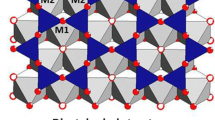Abstract
When Li-saturated montmorillonite is heated to 200–300 °C, the Li ions migrate from interlayer positions to sites in the layer structure. However, the identity of these sites has not been clearly established. Here we have investigated the migration of Li ions in montmorillonite, after heat treatment at 250 °C, using chemical and instrumental analyses. The latter include X-ray diffractometry (XRD), 7Linuclear magnetic resonance (NMR) spectroscopy and X-ray photoelectron spectroscopy (XPS). Heating causes a large reduction in cation exchange capacity (CEC) and an almost complete loss of interlayer expansion with glycerol as shown by XRD. Static and magic angle spinning (MAS) 7Li-NMR spectroscopy shows that the quadrupole coupling constant of Li increases markedly over the corresponding value for unheated Li-montmorillonite (where Li occupies exchange sites in the interlayer space) and for hectorite (where Li is located in the octahedral sheet). This would indicate that, in heated montmorillonite, Li occupies structural sites of low symmetry which, however, cannot be identified with octahedral vacancies in the layer structure as is commonly assumed. XPS shows that the binding energy (BE) for Li in unheated montmorillonite is comparable to that for other exchangeable cations. Heating broadens the Li 1s band and decreases the BE. The BE for Li in heated montmorillonite is significantly higher than that in either spodumene or lepidolite, where Li is known to occupy octahedral sites. The combined data suggest that heating induces Li to migrate from interlayer sites to ditrigonal cavities in the tetrahedral sheet, rather than into vacancies in the octahedral sheet, of montmorillonite.
Similar content being viewed by others
References
Alvero R, Alba MD, Castro MA, Trillo JM. 1994. Reversible migration of lithium in montmorillonites. J Phys Chem 98: 7848–7853.
Bailey SW. 1966. The status of clay mineral structures. Clays Clay Miner 14:1–23.
Behrens H-J, Schnabel B. 1982. The second order influence of the nuclear quadrupole interaction on the central line in the NMR of quadrupolar nuclei using rapid sample spinning. Physica 114B: 185–190.
Blakemore LC, Searle PL, Daly BK. 1987. Methods for chemical analysis of soils. NZ Soil Bureau Sci Rep 80. 103 p.
Brown G, Newman ACD, Rayner JH, Weir AH. 1978. The structures and chemistry of soil clay minerals. In: Greenland DJ, Hayes MHB, editors. The chemistry of soil constituents. Chichester: J. Wiley, p 29–178.
Calvet R, Prost R. 1971. Cation migration into empty octahedral sites and surface properties of clays. Clays Clay Miner 19:175–186.
Deer WA, Howie RA, Zussman J. 1992. An introduction to the rock-forming minerals. 2nd ed. Harlow, UK: Longman. p 146–150.
Farmer VC, Russell JD. 1967. Infrared absorption spectrometry in clay studies. Clays Clay Miner 15:121–142.
Gonzalez-Elipe AR, Espinos JP, Munuera G, Sanz J, Serratosa JM. 1988. Bonding-state characterization of constituent elements in phyllosilicate minerals by XPS and NMR. J Phys Chem 92:3471–3476.
Goodman BA, Chudek JA. 1994. Nuclear magnetic resonance spectroscopy. In: Wilson MJ, editor. Clay mineralogy: Spectroscopic and chemical determinative methods. London: Chapman & Hall, p 120–172.
Greene-Kelly R. 1953a. Irreversible dehydration in mont-morillonite: II. Clay Min Bull 2:52–56.
Greene-Kelly R. 1953b. The identification of montmorillon-oids in clays. J Soil Sci 4:233–237.
Greene-Kelly R. 1957. The montmorillonite minerals. In: Mackenzie RC, editor. The differential thermal investigation of clays. London: Mineral Soc. p 140–164.
Hayashi S, Hayamizu K. 1990. Accurate determination of NMR chemical shifts in alkali halides and their correlation with structural factors. Bull Chem Soc Jpn 63:913–919.
Hofmann U, Kiemen R. 1950. Verlust der Austauschfahigkeit von Lithiumionen an Bentonit durch Erhitzung. Z anorg allgem Chem 262:95–99.
Iwasaki T, Onodera Y. 1995. Sorption behaviour of caesium ions in smectites. In: Churchman GJ, Fitzpatrick RW, Eggleton RA, editors. Clays: Controlling the environment. Proc 10th Int Clay Conf; 1993; Adelaide, Australia. Melbourne: CSIRO Publishing, p 67–73.
Jaynes WF, Bigham JM. 1987. Charge reduction, octahedral charge, and lithium retention in heated, Li-saturated smectites. Clays Clay Miner 35:440–448.
Klein K, Hurlbut CS Jr. 1993. Manual of mineralogy. 21st ed. New York: J. Wiley, p 475–478.
Lippmaa E, Magi M, Samoson A. Engelhardt G, Grimmer AR. 1980. Structural studies of silicates by solid-state high-resolution 29Si NMR spectroscopy. J Am Chem Soc 102:4889–4996.
Nishimura S, Scales PJ, Tateyama H, Tsunematsu K, Healy TW. 1995. An electrokinetic study of Li+ions fixed at the muscovite mica basal plane. In: Churchman GJ, Fitzpatrick RW, Eggleton RA, editors. Clays: Controlling the environment. Proc 10th Int Clay Conf; 1993; Adelaide, Australia. Melbourne: CSIRO Publishing, p 192–195.
Paterson E, Swaffield R. 1994. X-ray photoelectron spectroscopy. In: Wilson MJ, editor. Clay mineralogy: Spectroscopic and chemical determinative methods. London: Chapman & Hall, p 226–259.
Quirk JP, Theng BKG. 1960. Effect of surface density of charge on the physical swelling of lithium montmorillonite. Nature 187:967–968.
Sanz J, Serratosa JM. 1984a. 29Si and 27A1 high-resolution MAS-NMR spectra of phyllosilicates. J Am Chem Soc 106: 4790–4793.
Sanz J, Serratosa JM. 1984b. Distinction of tetrahedrally and octahedrally coordinated Al in phyllosilicates by NMR spectroscopy. Clay Miner 19:113–115.
Seyama H, Soma M. 1984. X-ray photoelectron spectroscopic study of montmorillonite containing exhangeable divalent cations. J Chem Soc, Faraday Trans 1, 80:237–248.
Seyama H, Soma M. 1985. Bonding-state characterization of the constituent elements of silicate minerals by X-ray photoelectron spectroscopy. J Chem Soc, Faraday Trans 1, 81: 485–495.
Soma M, Churchman GJ, Theng BKG. 1992. X-ray photoelectron spectroscopic analysis of halloysites with different composition and particle morphology. Clay Miner 27:413–421.
Tettenhorst R. 1962. Cation migration in montmorillonites. Am Mineral 47:769–773.
Whitton JS, Churchman GJ. 1987. Standard methods for mineral analysis of soil survey samples for characterisation and classification in NZ Soil Bureau. NZ Soil Bureau Sci Rep 79. 27 p.
Author information
Authors and Affiliations
Rights and permissions
About this article
Cite this article
Theng, B.K.G., Hayashi, S., Soma, M. et al. Nuclear Magnetic Resonance and X-Ray Photoelectron Spectroscopic Investigation of Lithium Migration in Montmorillonite. Clays Clay Miner. 45, 718–723 (1997). https://doi.org/10.1346/CCMN.1997.0450510
Received:
Accepted:
Published:
Issue Date:
DOI: https://doi.org/10.1346/CCMN.1997.0450510



